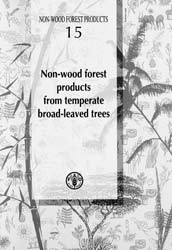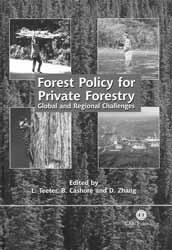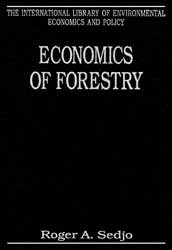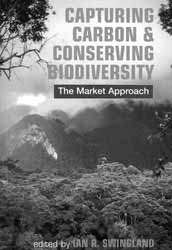Non-wood forest products from temperate broad-leaved trees. W.M. Ciesla. 2002. Non-wood Forest Products No. 15. Rome, FAO. ISBN 92-5-104855-X.

Temperate broadleaf forests provide a vast array of beneficial products. Many species have been domesticated and are represented by major fruit and tree crops worldwide, such as apple, pear, cherry, plum, olive, walnut and almond. In addition to fibre, timber and fuelwood, temperate broadleaf forests offer a wide range of non-wood forest products (NWFPs) that are of great benefit to human society in both developing and developed countries. Nevertheless, foresters have so far devoted little attention to enhancing the many non-wood uses of temperate forests.
This publication provides a global review of the non-wood forest products provided by trees found in temperate broadleaf forests. Descriptions of the products are organized according to the part of the tree from which they are obtained: entire tree, foliage and flowers, bark, resins, fruits, nuts, and associated organisms such as fungi and insects. Emphasis is placed on products harvested from either natural or planted forests as opposed to trees planted in orchards (e.g. stone fruits, olives and certain nuts). The geographical range of the products is indicated and, where available, data on levels of production and international trade are presented. Problems associated with the sustainable management of these products and compatibility or conflicts with other land uses are also discussed. Both contemporary and historical or traditional uses of NWFPs from temperate broad-leaved trees are discussed. The publication also provides a glossary, interesting recipes using the products and a convenient list of the tree species and the non-wood forest products they provide.
The information presented may help in identifying opportunities for management and production of non-wood forest products as an integral part of economic development and poverty alleviation initiatives in economically depressed regions of the world where trees are environmentally and socio-economically important. In addition, this information is also designed to help identify situations where special management of forests and woodlands may be appropriate to maintain or enhance the productivity of NWFPs or to develop a potentially beneficial new resource. The publication will be of interest to those involved in the forestry, agriculture and rural development sectors as well as to conservation agencies in developed and developing countries.
Non-wood forest products from temperate broad-leaved trees is also available on the Web (www.fao.org/DOCREP/005/Y4351E/Y4351E00.HTM).
FAO Conservation Guides. 2003. Double CD-ROM. Rome, FAO. ISBN 92-5-004907-2.

FAO’s Conservation Guide series addresses issues relating to forest conservation in general and more specifically forest ecology, conservation and wildlife management, watershed management and forestry in fragile ecosystems. Recently the collection has included publications on agroforestry and urban and peri-urban forestry. During the past ten years the collection has included a number of interesting documents covering the issues and challenges related to conservation and sustainable development in line with Agenda 21, with a particular focus on mountain ecosystems, drylands, protected area management and wildlife resources development.
As for any collection, it is a challenge to keep a complete set as the collection grows and as earlier volumes disappear from print or become difficult to obtain. The idea of collating the collection in a compact disc stems from this observation. The collection covers all 34 volumes in the series, issued from 1977 to 2000, most of them in three languages. The first CD contains the English editions, while the second contains the French and Spanish editions. This valuable compendium will not only help to keep the collection together, but will also make it easier to share the information contained in this useful series.
Forest policy for private forestry: global and regional challenges. L. Teeter, B. Cashore and D. Zhang, eds. 2003. Wallingford, UK, CABI Publishing. ISBN 0-85199-599-3.

Private forestry has become the focus of increasing scrutiny and concern as governments, non-governmental organizations (NGOs), businesses and professional foresters attempt to define, address and develop the most appropriate policies for implementing sustainable forest management. Private forestry can contribute to sustainability; however, increased understanding of the impacts of different policy choices on private forestry is needed.
This publication presents a selection of peer-reviewed papers from the conference Global Initiatives and Public Policies: First International Conference on Private Forestry in the 21st Century, which was held in Atlanta, Georgia, United States in 2001. Addressing the key issues currently shaping the future of private forestry, this book is presented in four parts.
The first part considers the changing philosophies of forest management and outlines how society’s perceptions of forests and forestry are changing, fostering the emergence of a new paradigm for public involvement in private forestry. Part 2 discusses policy design and implementation. It proposes a number of mechanisms for promoting policies that encourage sustainable private forestry such as:
The economic challenge to implementing and promoting sustainable forestry is highlighted in the third part of the book. The effects of forest-sector activities and policies on agriculture, biodiversity conservation and carbon sequestration are considered here from an economic perspective. Part 4 is devoted to forest certification, which has attracted the attention of various groups with diverse interests, including environmentalists, NGOs, government and the private sector, with a goal of improving forest management standards.
The book will be of interest to forest owners, forest industry decision-makers, policy-makers and students of forestry and natural resource economics and policy. Forest policy for private forestry: global and regional challenges is also availableelectronically (www.cabi-publishing.org/Bookshop/ReadingRoom/0851995993.asp).
Economics of forestry. R.A. Sedjo, ed. 2003. Aldershot, Hants, UK, Ashgate
Publishing Limited. ISBN 0-7546-2237-1.

Economics of forestry is a recent addition to the International Library of Environmental Economics and Policy, a series of volumes compiling significant journal essays in key areas of environmental and resource policy. This volume explores the influence of forestry economics on the development of forest and environmental policy. It comprises some of the most influential journal articles published on forestry economics in the past half century.
The publication is organized into four parts. The first part concentrates on the question of the optimal length of harvest rotations to maximize income. The articles in this part consider factors that may affect the value of the timber and the optimal rotation, such as taxation, natural disturbances, technological advances and price fluctuations.
Part 2 addresses economic issues related to the long-term supply of timber – which interestingly has characteristics of both non-renewable and renewable resources. Topics discussed include forest draw-down or rate of exploitation, forest management, regeneration and planted forests.
Part 3 addresses multiple use, including non-timber values of forests such as water management, recreation, biodiversity conservation, and other sociocultural values. The articles in this part illustrate the evolution of forest economics from a single focus on timber to inclusion of the multiple uses and values of forests.
Global environmental issues which receive considerable attention in forestry and forest economics, such as climate change and biodiversity, are addressed in the final section. The articles address such issues as the economics of carbon sequestration through silvicultural management and the valuation of biodiversity, biodiversity loss and associated losses in economic value.
The introduction to the volume provides a useful overview of the topic. The editor acknowledges that many important contributions to the field have been published as books and monographs and therefore could not be included in this compendium. However, despite this limitation, the publication provides a broad historical overview of the main currents in economic analysis that have significantly influenced the development of forestry policy.
Capturing carbon and conserving biodiversity: the market approach. I.R. Swingland, ed. 2002. London, UK, Earthscan Publications Ltd. ISBN 1-85383-951-5 (paperback); 1-85383-950-7 (hardcover).

Conventional donor-driven conservation efforts have often demonstrated little success in protecting the environment and the livelihoods of people who depend on it. Efforts are now focusing on alternative methods for supporting sustainable livelihoods while simultaneously conserving the environment. Capturing carbon and conserving biodiversity discusses the benefits – particularly in the developing world – of market-based approaches to environmental management, focusing on carbon sequestration. The publication presents a collection of papers from a diverse group of academics, conservationists, scientists, financial specialists, economists, lawyers and community and tribal specialists. They suggest that carbon market approaches can help conserve biodiversity, protect watersheds and support sustainable livelihoods while helping to curb global warming.
The publication explores the relationships of forests, carbon and global climate; introduces market-based mechanisms as cost-effective means of environmental conservation; and explores the range of instruments available to help develop carbon markets. It will be of interest to those involved with policy, research, practical conservation or the business development of carbon markets.